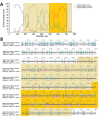Possible Bat Origin of Severe Acute Respiratory Syndrome Coronavirus 2
- PMID: 32315281
- PMCID: PMC7323513
- DOI: 10.3201/eid2607.200092
Possible Bat Origin of Severe Acute Respiratory Syndrome Coronavirus 2
Abstract
We showed that severe acute respiratory syndrome coronavirus 2 is probably a novel recombinant virus. Its genome is closest to that of severe acute respiratory syndrome-related coronaviruses from horseshoe bats, and its receptor-binding domain is closest to that of pangolin viruses. Its origin and direct ancestral viruses have not been identified.
Keywords: COVID-19; SARS-CoV-2; bats; coronavirus disease; genomic analysis; recombinant virus; recombination; respiratory infections; severe acute respiratory syndrome coronavirus 2; viruses; zoonoses.
Figures


References
-
- World Health Organization. Coronavirus disease 2019 (COVID-19) situation report 50, March 10, 2020. [cited 2020 Apr 11]. https://www.who.int/docs/default-source/coronaviruse/situation-reports/2...
MeSH terms
LinkOut - more resources
Full Text Sources
Other Literature Sources
Molecular Biology Databases
Miscellaneous

